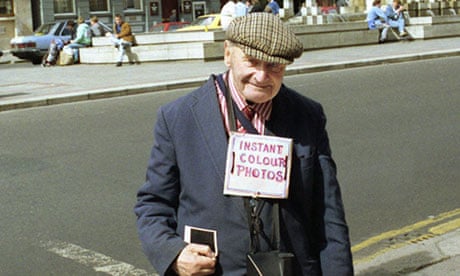For more than 50 years, Arthur Fields was known in Dublin as the man with the camera on O'Connell bridge. From the early 1930s until 1985, he snapped passers-by all day every day, amassing an estimated 182,500 photographs of ordinary people in his lifetime. Sometimes, he shot street portraits of famous people who happened to be passing, including the playwright Brendan Behan, actors Margaret Rutherford and Gene Tierney, as well as a passing African prince in headdress and fur coat. "He targeted everybody," says his son Philip, "It didn't matter who they were. A lot of Dublin people knew my dad and they have fond memories of him."
Now, Fields's story is in the process of being turned into an interactive web-based documentary by El Zorrero Films called Man On Bridge. Knowing that there must be thousands of his snapshots buried in cupboards and drawers all over Ireland, the film-makers aim to tell the world about the dogged street photographer by encouraging people to submit their pictures to an online archive.
Born Abraham Feldman in 1901, Arthur Fields was from a Ukrainian Jewish family who fled antisemitism in Kiev in the early 1900s and settled in Dublin. Initially he ran a sound studio, where people could make a recording of their own voice to take home, but it was when he bought a box camera that he began his life's work.
"He became a Dublin institution by standing on the city's main bridge 365 days a year," says El Zorrero's Ciaran Deeney. "Arthur lived in Raheny, a suburb about seven miles from the city centre, and he walked to and from work every day. He worked for himself and sold the snapshots. He would pretend to take a picture of a passer-by and, when they stopped, he'd take the real one. Then he'd give them a ticket and they could collect the photograph from a nearby studio run by his wife. She developed all the photos."
Arthur was one of several snapshot photographers, including his brother David, who stationed themselves on O'Connell bridge at the south end of the city's main thoroughfare. "He had a social life on the bridge with the photographers and other people he got to know," remembers Philip. "It's what he loved to do." And he did it for longer than any of his competitors. "There was probably no man who ever stood on O'Connell bridge for more hours than our dad," his other son, David, noted on a self-made YouTube video in 2011. In the 1960s, as camera technology improved, Fields switched to a Polaroid instant camera and his catchphrase became "Give it to you now!"
Now, Arthur Fields's photographs are also being recognised as a social record of Dublin though the decades from the 1930s to the 1980s, in which clothes styles, haircuts and shopfronts change. He captured couples, families, tourists, and Dubliners, often with the city's most famous landmark, Nelson's Pillar, in the background further up O'Connell Street. (It was blown up by Irish Republicans in 1966.) He shot passing teddy boys in the 1950s, mini-skirted girls in the 1960s and the city's punks and skinheads in the 1970s as they passed over the bridge.
Some early Super 8 footage of Arthur at work shows a long-gone Dublin. Four creamy-yellow public telephone boxes are visible in the background and similarly coloured double-decker buses cross O'Connell bridge though a sea of pedestrians and cyclists. In another snapshot of him, taken decades later, it is the golden double arch of the McDonald's logo that's visible behind Arthur and his Polaroid camera.
If all goes according to plan, the man on the bridge's epic project will be given new life online. El Zorrero Films is in the running for a grant from Arthur Guinness Projects, which is awarding bursaries of up to €50,000 for "people with innovative, inspiring, brilliant ideas and the passion and drive to make them happen". (You can vote for their proposed film here.
The online project will grow as people submit their photographs, a fitting epitaph to a dogged individual who became as famous, in his own way, as any of the city's landmarks. "To be able to endure for 50 years, you have to love your job," says Philip Fields. "It was his life."

Comments (…)
Sign in or create your Guardian account to join the discussion